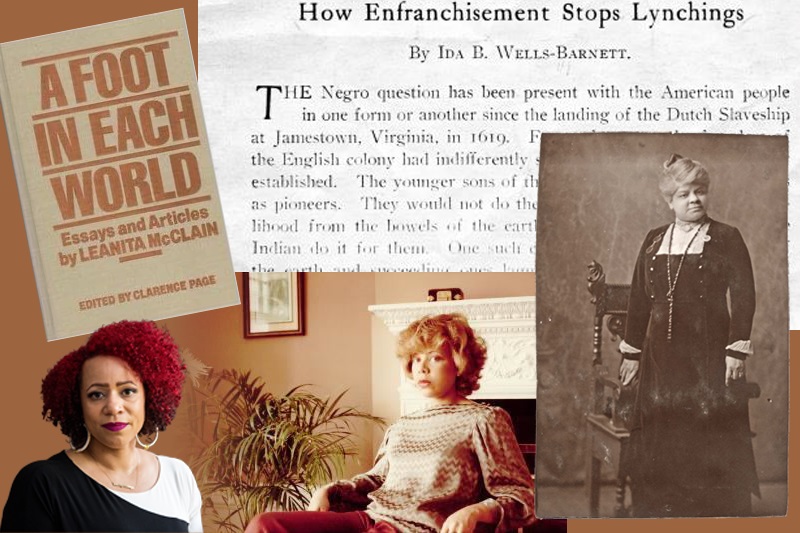University Libraries

'A Foot in Each World'
By Maureen Schlangen
Content warning: This post contains content about suicide.
Thirty years ago as a young journalist, I read a book of essays and articles by the late Chicago Tribune columnist Leanita McClain that thoroughly changed my white, suburban understanding of race and politics. Though McClain’s coverage and commentary now go back more than a generation, their relevance to today’s racial and political climate caught me by surprise when I reread the book in 2021.
As a 28-year-old journalist covering city politics for the Chicago Tribune, McClain captured nationwide attention with an October 1980 essay in Newsweek about the stress of being a successful Black professional in white America.
“I have fulfilled the entry requirements of the American middle class, yet I am left, at times, feeling unwelcome and stereotyped,” she wrote. “I have overcome the problems of food, clothing and shelter, but I have not overcome my old nemesis, prejudice. Life is easier, being black is not. … I run a gauntlet between two worlds, and I am cursed and blessed by both. I travel, observe and take part in both; I can also be used by both. I am a rope in a tug of war. … I have a foot in each world, but I cannot fool myself about either.”
Following the essay, McClain’s already stellar career at the Chicago Tribune took off. Her pieces on politics, housing, crime, education and social issues provoked and challenged the powerful, stimulated conversation, captivated readers and gave white people a glimpse of the realities of being Black in Chicago and in America.
Three years later, after a contentious mayoral election that brought racism to the surface in the people she lived with, commuted with, worked with and covered, she published a guest column in The Washington Post titled “How Chicago Taught Me to Hate Whites." Sparking affirmation, criticism, introspection and even charges of racism, it made McClain a leading voice in national conversations on race. She stood by her words.
“Yes, the article is a representation of the inner workings of a black mind,” she is quoted in the book’s preface to the essay. “But it could have been one of any number of professions. I just happen to be a woman working at the Chicago Tribune. But there were so many black people — schoolteachers, movie ushers — who could have come up with the same emotions and hurts.”
The stress of the two worlds McClain occupied took the kind of toll that academia has since documented as the mental and physical effects of code switching, prejudice and racism. On Memorial Day of 1984, at the age of 32, McClain died of an intentional overdose.
McClain’s writing often jarred her readers. She made people — particularly those who are white — uncomfortable, and she did this by telling the truth.
In the 1890s, so did the journalist Ida B. Wells with her reporting on segregated schools, lynchings and the women’s suffrage movement. Wells lost a teaching job over her criticism of segregation. After she wrote in her own newspaper about the lynching of two Black men, a mob came after her, too. She was out of town at the time, but they destroyed her newspaper office and her equipment. In 2020, 89 years after her death, Wells won a Pulitzer Prize for her “outstanding and courageous reporting on the horrific and vicious violence against African Americans during the era of lynching."
And 36 years after McClain made people uncomfortable with her Washington Post column, investigative journalist Nikole Hannah-Jones and a team of reporters at The New York Times followed suit with the 1619 Project, which sought to deliver a fuller though more brutal picture of American history that didn’t soften or conceal the role slavery played in the birth of the nation. It made some people so uncomfortable that they initiated legislation to ban it from schools and universities.
The uncomfortable truth is: Truth isn’t always comfortable. Nor is the startling timelessness of McClain’s book.
Recommended Reading
- A Foot in Each World: Essays and Articles by Leanita McClain is available through OhioLINK.
- Works by Ida B. Wells are available through Roesch Library.
- The 1619 Project: a New Origin Story, edited by Nikole Hannah-Jones, Caitlin Roper, Ilena Silverman and Jake Silverstein, is available through Roesch Library.
- The University Libraries have a research guide on Black History Month with additional resources: https://libguides.udayton.edu/bhm
- Suicide prevention: If you or someone you know is experiencing suicidal thoughts or a crisis, call the Suicide Prevention Lifeline at 800-273-8255. Or, contact the Crisis Text Line for emotional crisis support by texting HELLO to 741741. It is free, available 24/7 and confidential.
About the image
Clockwise from top left: A Foot in Each World cover; a news story written by Ida B. Wells; a portrait of Ida B. Wells; a candid photograph of Leanita McClain; and a photograph of Nikole Hannah-Jones. Creator: Ann Zlotnik.
— Maureen Schlangen is an e-scholarship and communications manager and a member of the University Libraries Diversity and Inclusion Team. She was a newspaper reporter and editor before joining the University in 1997.
